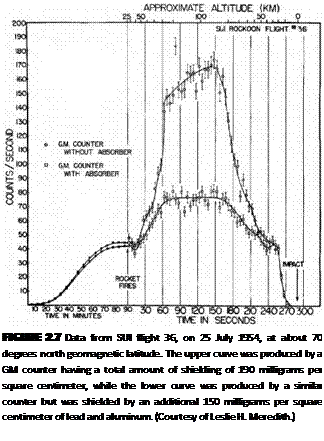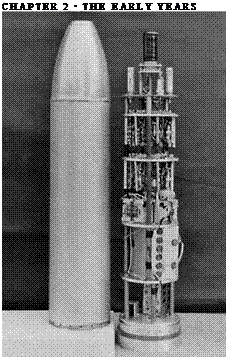A great personal adventure, summer 1955
An ambitious rockoon expedition was mounted in 1955 as a follow-up to the earlier ones. It had three goals. The first was to further clarify the latitude distribution and nature of the auroral soft radiation observed during 1953 and 1954. The second was to continue the original cosmic ray latitude survey by testing a new lighter-weight and even less expensive rockoon. And the third objective was to test a two-stage rockoon configuration in an attempt to reach even higher altitudes.
Frank McDonald was the principal investigator for the first of those objectives and served as the expedition’s team leader. He used the well-tested Deacon rockoon configuration, but with a more advanced instrument that combined most of the features

 |
OPENING SPACE RESEARCH
of the separate instrument packages flown in 1954. It included the twin-GM counters with different amounts of shielding, plus a scintillation detector generally similar to that used in 1954, but with two important changes. The 1954 detector had been coupled with an additional GM counter to form a telescope to determine the directional characteristics of the auroral soft radiation. Since that radiation had proved to be too soft to activate the telescope, that GM counter was dropped for 1955. Second, a nose cone of somewhat thinner material was used, and the scintillator crystal was located beneath a 0.002 inch thick titanium foil window at the tip of the nose cone to further reduce the amount of shielding in front of that detector. The 1955 instrument package is shown in Figure 2.8 beside its nose cone shell.
I participated in that operation as an undergraduate senior. The preparatory work became all-consuming during the summer, beginning immediately after I finished my spring semester courses. I did much of the design, construction, and testing of Frank’s new instruments. I also developed and set up the associated ground receiving, processing, and recording station used during the expedition to recover the flight data and, upon our return, to process the data for analysis.
FIGURE 2.8 The Deacon instrument payload for the summer 1955 rockoon expedition. The scintillation counter is at the top, followed by the two GM counters. Next are two decks containing scaling circuits, a deck containing miscellaneous electronic circuits, the batteries, and finally, the transmitter. The flat on top of the nose cone contains the thin titanium window for the scintillation detector. The complete payload weight was about 40 pounds. (Courtesy of the Department of Physics and Astronomy Van Allen Collection, The University of Iowa, Iowa City, Iowa.)
 It was a special thrill for me to accompany the field expedition in the early fall. The work on that project provided excellent advanced training in the techniques of high-reliability instrument building and scientific field operations that was invaluable when I began designing satellite instruments the following spring.
It was a special thrill for me to accompany the field expedition in the early fall. The work on that project provided excellent advanced training in the techniques of high-reliability instrument building and scientific field operations that was invaluable when I began designing satellite instruments the following spring.
The second goal of the 1955 expedition was to develop and test a smaller rocket and payload to further exploit the advantages of the rockoon technique. Van Allen had thought that a three inch diameter Loki Phase I rocket might be used in place of the six inch Deacon. He had discovered that a considerable number of those surplus Loki rockets were stocked within the Army Ordnance Department, and some of them were made available to SUI without cost through arrangements by his friend and colleague, William H. Pickering, director of the Jet Propulsion Laboratory in Pasadena, California. Those lighter payloads could be lofted by smaller balloons—39 feet in diameter with a volume of 26,000 cubic feet—which were available at a cost of only about $200. The lighter weight and smaller size of the Loki configuration had another big advantage in that it was easier to handle and launch than the larger Deacons.
Van Allen’s vision was that, if a meaningful instrument could be made sufficiently small and light in weight, a substantial fleet of them might be flown as a part of the SUI scientific contribution to the upcoming International Geophysical Year. When he met with his new graduate students in August 1954, this was among the new ideas
OPENING SPACE RESEARCH
![]() that he put on the table for consideration as research projects. Carl McIlwain was one of those new graduate students.
that he put on the table for consideration as research projects. Carl McIlwain was one of those new graduate students.










